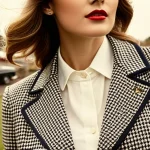Historical Context of British Fashion
British fashion history is rich and diverse, heavily influenced by the cultural shifts and societal changes across different eras. From the regal attire of the Elizabethan period to the eclectic styles seen today, each epoch has left a distinctive imprint on both fashion and beauty trends. In particular, women’s beauty standards have evolved alongside these changes, often reflecting the broader cultural milieu of the time.
Major historical eras like the Victorian period introduced conservative beauty ideals, emphasizing modesty and restraint. Women’s style preferences during this time were heavily influenced by societal norms that dictated modesty. Corsets and voluminous skirts created silhouettes that were considered ideal feminine forms.
Have you seen this : How Does the UK Define Beauty for Women Today?
As we transitioned to the 20th century, the impact of the Edwardian era brought about softer styles and more natural beauty ideals. This era saw a shift towards practicality in women’s fashion, blending functionality with elegance. The role of technological advancements during this period also cannot be understated, as mass production facilitated greater access to varied beauty products and clothing.
The post-war periods brought significant style transformations, shifting from traditional modes of dress to more modern aesthetics. The 1960s, characterized by bold, youthful fashion, saw a departure from conservative beauty norms. The rise of street style and fashion subcultures during the 70s and 80s further redefined beauty standards, pushing boundaries and challenging established ideals. Each era contributed layers to the broad tapestry of British fashion history, illustrating how women’s beauty trends are deeply intertwined with cultural influences.
Also to discover : How Can Understanding UK Fashion Trends Enhance Women’s Beauty Routines?
Key Fashion Movements in the UK
The landscape of British fashion has been shaped by numerous iconic trends and fashion movements, each leaving an indelible mark on women’s beauty standards. The Mod era, celebrated for its clean lines and bold graphics, revolutionized the British style scene. This period emphasized youthful exuberance, reflected in both the fashion movements and adventurous makeup trends of the time. The Mod movement’s minimalistic approach to fashion encouraged simple, geometric makeup and sleek hairstyles, setting a new standard for beauty.
Simultaneously, the rise of the Punk movement in the late 1970s brought a rebellious twist to British style evolution. This era was characterized by its subversive aesthetics, with fashion becoming a canvas for self-expression. Bold hairstyles and dramatic makeup were central to this look, challenging the conventional beauty norms and celebrating individuality. These fashion movements exemplified the powerful interplay between style and personal identity, reshaping women’s beauty definitions.
Street style and subcultures continue to play a pivotal role in shaping beauty standards. The vibrancy of styles witnessed in urban settings frequently seeps into mainstream fashion, demonstrating the dynamic nature of British style evolution. From the diversity of subcultures has sprung a rich amalgamation of influences, weaving together different strands of identity and aesthetics in women’s fashion. British designers, renowned for their ingenuity, have consistently embraced these changes, fostering a symbiotic relationship between high fashion and street trends.
Influential Designers and Their Impact
British fashion designers have significantly influenced style innovation and evolved women’s beauty perceptions. Iconic figures such as Vivienne Westwood and Alexander McQueen have seamlessly integrated avant-garde design philosophies into their collections, challenging and reshaping mainstream beauty standards.
Westwood, known for her daring approach to British fashion history, revolutionized punk aesthetics with her bold, rebellious creations. Her designs often incorporated elements that questioned traditional beauty influences, inspiring a generation of women to embrace individuality through unique makeup and hairstyles. Similarly, McQueen’s theatrical runway shows explored dramatic themes, blending art with fashion. His designs regularly featured unconventional beauty trends, such as exaggerated makeup styles and striking hair sculptures, further emphasizing the relationship between fashion and self-expression.
The collaborations between these designers and beauty brands have also had a profound impact on women’s beauty trends. By integrating specific makeup looks and hairstyles into their collections, they have left an indelible mark on contemporary beauty standards. These interactions highlight the dynamic interplay between beauty trends evolution and fashion, demonstrating how stylistic innovation can redefine societal perceptions of beauty. Such design collaborations continue to fuel beauty transformations, emphasizing the integral role of fashion in shaping beauty norms.
Incremental Shifts in Beauty Trends
British fashion history has profoundly influenced beauty trends evolution, with makeup styles and hairstyles mirroring changes in style preferences across different epochs. As these trends evolved, they often reflected the broader cultural influences of the time. During the Victorian era, women’s beauty trends leaned towards conservative styles, with makeup used subtly to enhance features in line with modest societal expectations. However, as we moved into the 20th century, beauty ideals shifted towards more daring and expressive looks.
Makeup styles became bolder with each passing decade, as evidenced in the 1960s when dramatic eye makeup and bright lip colors became fashionable during the Mod era. This change symbolized a shift towards youthful exuberance and British style evolution. Similarly, the Punk movement in the late 1970s introduced makeup that challenged norms through exaggerated features and bold color choices, aligning perfectly with its rebellious fashion aesthetics.
Hairstyles too have played a crucial role in reflecting fashion movements over the decades. From the elaborate updos of the Edwardian era, which mirrored the shifting notions of elegance and practicality, to the sleek, geometric styles of the Mod era, and the wild, untamed looks of Punk, hair has always been a vital form of personal expression. Today, contemporary beauty standards continue to be shaped by past styles, illustrating that while beauty trends evolve, they often draw inspiration from historical influences. This ongoing dialogue between the past and present underscores how deeply intertwined fashion and beauty are within British cultural history.
Impact of British Fashion on Global Beauty Norms
British fashion has long exerted a profound influence on global beauty standards, reshaping aesthetic norms well beyond its borders. This transnational impact can be traced back to various epochs where British style significantly swayed international trends, notably reflecting the UK’s evolving identity in women’s beauty trends. As British fashion icons emerged, their distinct styles often prompted a broader acceptance of diverse beauty ideals worldwide.
One compelling example is the Swinging Sixties in London, a period marked by bold, youthful fashion movements, pivotal in transforming global beauty perceptions. British designers like Mary Quant popularized the miniskirt, alongside vibrant makeup looks that championed individuality and self-expression. Such stylistic innovation not only captivated domestic audiences but also fostered changes abroad, inspiring similar trends in cities like New York and Paris.
Additionally, fashion icons like Twiggy and Kate Moss became emblematic of British style abroad, further cementing the UK’s aesthetic influence. Twiggy’s boyish looks and pixie haircut introduced a fresh beauty standard that challenged conventional norms, while Moss’s waifish look shaped beauty ideals during the 1990s. These style ambassadors signified a symbiotic relationship between British fashion and global beauty ideologies.
Today, British fashion continues to cultivate beauty standards worldwide through influential designers whose collections challenge traditional aesthetics. In this sense, the interconnectedness of British fashion and global beauty acceptance underscores the enduring impact of British style on women’s beauty trends across the globe. This pervasive influence illustrates how British creativity has become a driving force in shaping contemporary beauty perceptions, continuously inspiring evolutions within the aesthetic landscape.
Case Studies on Fashion and Beauty Interplay
Fashion case studies offer intriguing insights into how historical and modern fashion moments intricately weave beauty trends. One notable instance is the Swinging Sixties, a vibrant era known for its transformative impact on both fashion and beauty. This period saw designers like Mary Quant elevate bold makeup looks to mainstream popularity, aligning with the era’s penchant for innovative self-expression. Quant’s introduction of the miniskirt not only influenced clothing but directly impacted beauty standards by prioritizing youthful and dynamic aesthetics.
Another seminal case study lies in the Punk movement—a movement that carved out space for beauty standard examples that defied traditional norms. Designers like Vivienne Westwood harnessed the subversive energy of punk to craft styles that celebrated individualism and non-conformity. This movement’s emphasis on bold hairstyles and dramatic makeup challenged societal beauty conventions, demonstrating how fashion can redefine aesthetics.
Further exploring stylistic analysis, Alexander McQueen’s runway shows provide a compelling example of how theatrical elements in fashion present opportunities to challenge existing beauty norms. His collections regularly featured avant-garde beauty trends, such as exaggerated and unorthodox makeup styles, blending the lines between art and fashion. McQueen’s work underscores the profound synergy between innovative fashion and progressive beauty transformations.
Ultimately, these case studies reveal how pivotal fashion moments directly inform beauty standards, illustrating the crossover between fashion and beauty industries. They exemplify how groundbreaking collections and runway shows have the power to shift societal perceptions, creating new benchmarks for beauty across various epochs.
Visuals and Illustrative Examples
Understanding the evolution of British fashion history and its impact on women’s beauty trends requires us to delve into the visual realm. Visual content, including photography, media, and beauty illustrations, plays a crucial role in capturing and communicating the essence of various fashion epochs.
Iconic British looks like the bold, geometric lines of the Mod era or the rebellious Punk styles provide vibrant examples of how fashion movements align with beauty trends. These styles offered stylistic visuals that often challenged or redefined existing cultural influences, pushing the boundaries of women’s beauty standards at the time.
Illustrative examples of these trends can be seen in high-fashion magazines, which historically have acted as both mirrors and magnifiers of societal trends. Fashion editorials and runway photographs not only document the garments but also set the stage for style examples that are often imitated by the public.
Photography and media have played pivotal roles in shaping and disseminating these beauty perceptions. The images captured in these mediums immortalize fashion moments, offering a tangible reference to past styles. Throughout British fashion history, the dissemination of visuals has ensured that influential looks and beauty trends extend beyond their origins, permeating both domestic and international fashion landscapes. Thus, visual representations not only guide contemporary fashion choices but also enrich our understanding of how style and beauty have evolved over centuries.





